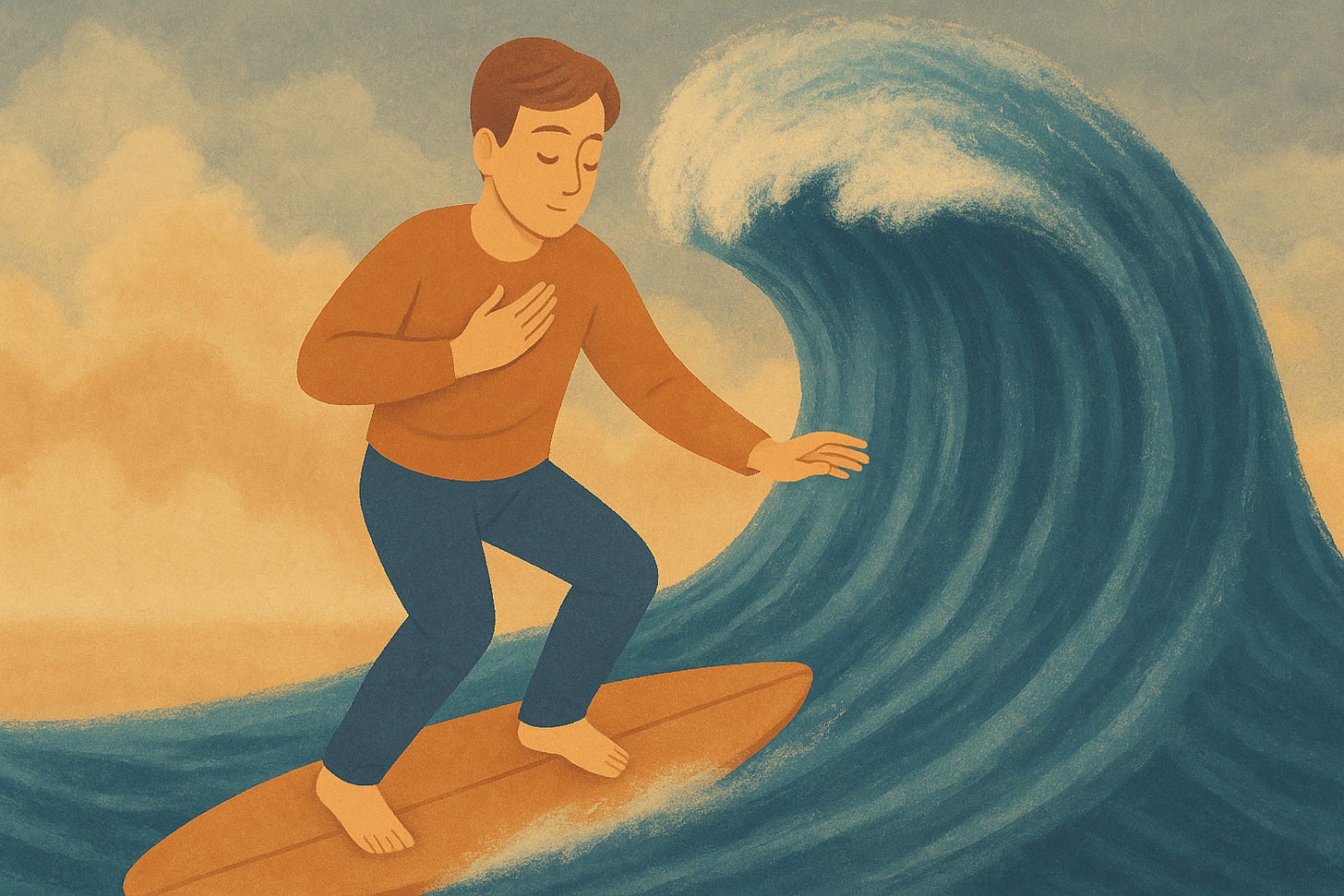How to Ride the Wave: A Self-Compassionate Approach to Big Feelings
What brain science reveals about emotions—and how self-compassion helps us ride the wave instead of getting pulled under.
Have you ever been jolted awake just after falling asleep by a sudden wave of fear?
It happened to me recently—for the first time in ages Just as I was drifting off, a story laced with self-doubt and fear of failure popped into my head.
But something in me paused. I felt the surge of energy move through my body. And instead of spiraling, my mindfulness muscle kicked in. I noticed the story, felt the sensations, and remembered: I don’t have to believe everything my brain tells me.
So I simply said OK. I didn’t push it away or try to fix it. I let it be. I placed a hand over my chest—offering myself kindness, the way I might comfort a frightened child.
Within a minute or two, the sensations softened. The story faded. And I gently drifted back to sleep.
Reflecting on it, I realized that moment was a perfect example of the fleeting nature of emotions.
According to brain scientist Dr. Jill Bolte Taylor, an emotional reaction in the body—at its core—is a chemical process that lasts about 90 seconds.
Just 90 seconds.
What keeps the emotion going isn’t the feeling itself—it’s what we think about the feeling. We layer on judgment, fear, blame. And that mental storytelling? That can turn a gentle wave into a tsunami.
A Doorway to Self-Compassion
When big feelings hit, our first instinct is often self-judgment:
“I shouldn't be feeling this.”
“What’s wrong with me?”
But instead of following that old, familiar script, we can choose something different. We can meet ourselves with kindness.
First, let’s understand the terrain. Emotions aren’t just “in your head”—they’re physical experiences. A tight chest. A racing heart. A knot in the stomach.
If we can stay present and feel those sensations, without immediately reacting, we create space. A small but mighty pause. That 90-second window becomes a doorway to compassion instead of criticism.
And that matters. Because unacknowledged emotions don’t vanish. When ignored or suppressed, they often become background noise—lingering sadness, chronic tension, quiet discontent. Emotional clutter that weighs us down.
Even more powerful is what happens after the 90 seconds. If we continue spinning painful stories like:
“I always mess up.”
“No one else feels this way.”
“I’m just too sensitive.”
we prolong the emotional wave. Our thoughts trigger new signals to the body, and the loop continues.
This is where suffering starts—not in the feeling itself, but in our resistance to it.
So next time you feel overwhelmed, remember: the feeling is temporary. What lasts is the relationship you build with yourself in that moment.
Invite a Pause & Practice Self-Compassion
The keys to riding out that wave without amplifying it are: take a pause and invite self-compassion.
Self-compassion interrupts the cycle of habitual response. It creates safety within us, allowing emotions to move through rather than get stuck. In that safety, healing happens. From that place of care, we respond more wisely, gently, and authentically.
When a strong emotion arises, invite a pause, notice your breath or another bodily sensation that feels resourcing. Then, you could send a message like the following inward:
“This is a hard moment. I’m allowed to feel this. May I offer myself some kindness right now.” (Feel free to experiment to find out what works best for you.)
You can even place a hand over your heart or anywhere you feel uncomfortable sensations. These are simple signals of safety that remind your body you're here, you're okay, and you're not alone.
So next time you feel overwhelmed, remember: the feeling is temporary. What lasts is the relationship you build with yourself in that moment.
Choose kindness. Choose curiosity. Choose to be on your own side.
You don’t need to fix the feeling. You just need to feel it—with compassion. That is the foundation for true inner growth and healing.



